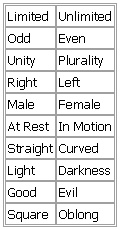opposites, table of
philosophy
in Pythagorean philosophy, a set of 10 pairs of contrary qualities. The earliest reference is in Aristotle, who said that it was in use among some contemporary Pythagoreans. But Aristotle provided no real information about its function in Pythagorean practice or theory or about its origin. Some scholars have detected possible archaic elements in it, but others have suggested that its originator was in fact Speusippus, Plato's nephew. Because no statements of Pythagoras have survived, and because Aristotle customarily accommodated pre-Socratic philosophy to his own terminology and problems, the problem is difficult to resolve.
Aristotle's table of the Pythagorean opposites is as follows:
Limited Unlimited
Odd Even
Unity Plurality
Right Left
Male Female
At Rest In Motion
Straight Curved
Light Darkness
Good Evil
Square Oblong
See as table:

Aristotle remarked that Alcmaeon of Croton, a medical writer, also had pairs of contraries as the first “principles” of things and also of most human things, but he did not know whether contemporary Pythagoreans influenced Alcmaeon in this regard or vice versa.
Aristotle associated moral prestige with the left-hand column, because the “good” things appear in that column. The table had some currency among Aristotle's contemporaries, perhaps in the Academy (Plato's school in Athens), but his references are made merely in the interest of supporting certain views of his own.
Aristotle's formal table has 10 members, because the Pythagoreans considered 10 the perfect number. But the pairs varied in different authors. Possibly no list or set number of opposites became canonical among the Pythagoreans.
- Puget Sound
- Pugin, A.W.N.
- Puglia
- Pugno, Raoul
- Pugwash Conferences
- Puig, Manuel
- puja
- Pujols, Albert
- Pukaki, Lake
- Pukapuka Atoll
- Pukaskwa National Park
- puku
- Pula
- Pulcheria
- Pulci, Luigi
- puli
- Pulicat Lake
- Pulitzer, Joseph
- Pulitzer Prize
- Pulkovo Observatory
- pulley
- Pullman
- Pullman, George M
- Pullman Strike
- pulmonary alveolar proteinosis